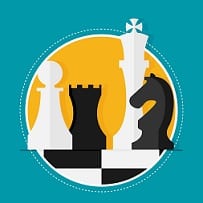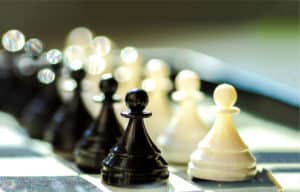
Individual Pieces
Pawns
The game begins with 16 Pawns on the Board …
8 White : 8 Black
Based on it’s standard number of square it can move per turn – i.e. 1 (one), the relative value of the Pawn is 1 point …
The value for each of the chess pieces helps you – roughly – determine when a piece is worth sacrifing (i.e. in exchange for you’re opponent’s piece; or for a strategic ploy) and when it’d be wiser not to lose the piece, if possible.
On that bombshell, it’s easy to think little of the Pawn’s merit other than to swap-off with your opponent’s Pawns; or do damage to a higher value piece of his and ignore the fact it’ll get taken next go.
However, the Pawn has a very useful trick up it’s, er, sleeve:
Pawn promotion: if you can manage to get just one Pawn to the back row of your opponent’s side of the Board, you can exchange it for an extra high-value piece … Knight, Bishop, Rook, or Queen … you get to choose.
[MORE INFO: Chess Glossary Article]
Knights
The game begins with 4 Knights on the Board …
2 White : 2 Black
The piece that – most often – “looks like horse“, is the Knight.
For each turn for the Knight, it gets to travel 3 squares of the Board, in a kind of elongated L-shape – you’ll see this better is the Basic Chess Moves section.
Of all the Chess Pieces at your disposal, the Knight is the only one that can jump over other pieces on the Board, to an unoccupied square, or onto a square occupied by your opponent.
(And no, just like with all of your other pieces, you cannot land your Knight on a square if one of YOUR pieces is already occupying it).
The relative value of the Knights is 3.
[MORE INFO: Chess Glossary Article]
Bishops
The game begins with 4 Bishops on the Board …
2 White : 2 Black
The Bishop moves on the Diagonal squares and can only capture another piece diagonally, like the Pawn chess pieces.
However, whereas the Pawn is limited to one square move to capture, the two Bishop chess pieces may take (or move) along any and all available diagonal squares – as far as from one corner of the Board to the other, providing line of sight isn’t obstructed.
Starting with two Bishops, at the beginning of the game, one occupies the White squares; the other occupies the Black squares.
As long as the way is clear, the Bishops can travel as many squares as is available – either to take up position, or to capture your opponent’s piece.
Together, they can be a formidable asset … However, at some point during the game, it’s likely you may have to decide to sacrifice one or the other.
Alternatively, the sacrifice may be between one of your Bishops and a Knight … as the relative value of the Bishop is also 3, like the Knight, as a beginner, I find it comes down to preference as to which one gets taken…
For instance, say you prefer combining the moves of the Bishops with your other major pieces – in that case, sod the horse (sorry, I mustn’t use that word… “sod the Knight“).
[MORE INFO: Chess Glossary Article]
Rooks
The game begins with 4 Rooks on the Board …
2 White : 2 Black
Apparently, there are folk of an excitable nature who spontaneously combust at the near mention of this humble of chess pieces being called “a castle” …
Yet, this confusion is dragged out of it’s hiding place and put on display, when mentioning the special move that takes place between the Rook and the King …
The name of the move? It’s called “Castling” – and it’ll be covered later on in the section on Basic Chess Moves.
Whereas the Bishops can only move along the diagonals, the Rook chess pieces can only move in straight lines, forward-or-backward, left-or-right.
Their weakness is they cannot move along the diagonals.
And while their unlimited square moves – to position or capture – are great threats to your opponent, beware threats to YOUR Rooks from diagonal attacks by your opponent…
Such threats could be at a distance, from your opponent’s Bishop or Queen … or they could come as a result of a sneaky combined attack using the one-move limited Pawns and even a cheeky one-square-stroll from their King.
Overall, the power-play options of the Rooks – especially together with each other, or in combination with, say, your Queen – means they just outrank either the Knights (3) or Bishops (3) and, in terms of relative value, the Rooks score 5.
[MORE INFO: Chess Glossary Article]
Queens
The game begins with 2 Queens on the Board …
1 White : 1 Black
See what I mean about how Chess Titans’ Queen chess pieces look – if I hadn’t said it was a Queen, could you have with certainty said it was the Queen and not the King?
… You could? I’ll get my coat, then.
On the way to get the coat, I managed to chisel out the rest of this page … And the bits dropped off to read something like this:
Forget the King for now, in terms of moves available, the Queen’s your most valuable asset.
The Queen manages to combine the diagonal range of moves available to the Bishop, with the straight line (foward-back/left-right) moves available to the Rook.
The one weakness regarding the Queen is?
YOU
Often, especially as a beginner, you can become so reliant on the seeming power of the Queen that attempts will be made to preserve its capture, at the expense of gaining strategic advantage…
Certainly, you want to have the Queen available long enough to inflict as much damage to as many of your opponent’s pieces as possible…
But, with the bonus available through Pawn Promotion, the Queen can be used as bait – sacrificed mid-game and returned later on to help complete victory.
Because of her lines and range of movement, the relative value of the Queen is 9.
[MORE INFO: Chess Glossary Article]
Kings
The game begins with 2 Kings on the Board …
1 White : 1 Black
Do you know the one thing that sets the two Kings apart from all the other chess pieces?
Kings CANNOT be captured!
Kings can be “checked” – that is to say, you can enforce a “check” on your opponent’s King by positioning any of your pieces in line of sight that would, for any other piece, result in capture should they not move out of capture-range on their next move.
When a King becomes “checked”, the next move – be it by yourself or your opponent (whoever’s King it is) – must be either to:
- Move your King out of check;
- (if possible) capture the piece causing the “checked” situation
- Use one of your pieces to block the line of sight of the piece that made the initial “check”*.
* If the King has been “checked” by a Knight, the only options are to either ‘capture’ it, or move the King out of the threatened square.
To simplify matters: before ANY other piece can be moved, the King must be removed from being “in check”.
Checkmate = Game Over … When either King is checked and CANNOT move to any other square because he’ll still be in check … and when you cannot capture any of the offending chess pieces to get you out of check …
Even if you haven’t downed your coffee, the GAME ENDS, IMMEDIATELY, IN “CHECKMATE” …
If that’s your King – YOU LOSE (very badly); if it’s your opponent’s King – HAPPY DAYS.
Because the King cannot be captured, technically there is no relative value that can be applied to the King …
If you wanted to argue about it – and some people can’t sleep at night without doing so – go read what Wikipedia has to say about valuing chess pieces.
Regarding movement, the King moves one square at a time, per turn – sure, he can move in any direction like the Queen, but like the Pawn, the one-square-move rule obviously makes the King vulnerable in open spaces …
To safeguard, it’s usually best to have some of your pieces strategically placed on adjoining squares – of all the chess pieces, this job is often done by the humble Pawn, while your other major pieces are engaged in their own pursuit of attack … or hara-kiri.
The only time the King moves more than one square per turn is during the special move, already mentioned, called “Castling”, which involves swapping squares with either of your Rooks and involves more of an explanation, which can be found in the Basic Chess Moves section.
[MORE INFO: Chess Glossary Article]
Collective Terms
Material
“Material” is the collective, catch-all term, sometimes used instead of saying “Chess Pieces“.
At the start of the game, both sides are equal, in terms of Material, with a full army of 16 pieces each, (including the King).
Even after a number of moves, in the Opening phase of a game, both sides may ignore capturing enemy Material, in favor of completing the Development of their forces.
However, such passive gameplay won’t last and, it’s not long before both players go on the attack, with Material being lost/captured on both sides.
In the above graphic, boths sides have lost a Pawn each; Black has lost 2 kNights; and White has lost a Bishop …
White is ahead in Material – or, you could also say White has the “Material advantage” – with 14 Chess Pieces remaining and leading Black by 1 piece (a kNight).
As the game plays on, further Material is, respectively, won and lost.
In the above graphic, White just retains a Material advantage, though his army has been reduced to 8 Chess Pieces, versus Black’s 7.
Back to the Chess Glossary (Material)
Minor Pieces
The Knights and Bishops are categorized as “Minor Pieces“, to reflect their worth on the Board, in relation to all the other pieces …
NOTE: Pawns, while being Chess Pieces, in form, aren’t considered as either Major– or Minor Pieces …
Like your common foot-soldier, which they represent, Pawns can be likened to the man on the street – they do the fighting; they’re more-expendable, in battle.
But, they’re NOT members of the so-called elite classes, such as the Nobles (Knights); high-ranking members of the Church (Bishops), or the Royals (Queen & King).
To avoid confusion, when referring to Chess Pieces, we’re talking about Knights, Bishops, Kings, or Queens …
But NOT the Pawns … They’re just “Pawns“. So, you have Pieces and you have Pawns.
Now, let’s have a look at the two Minor Pieces …
Knights Can Jump Obstacles
At the beginning of a game of Chess, besides the Pawns, the Knights are the ONLY OTHER Chess Pieces that can be the first to move.
Besides its unique L-shape pattern of movement, what makes the Knight valuable – in its Minor way – is its ability to jump over obstacles …
Depending on your perspective, a Knight, when properly used, can be a highly effective attacking unit – OR, a piece that can cause you problems, if you’re the side under attack!
Bishops Can Patrol Long Distances
While the Bishop takes a move longer, to get into active duty; once its Diagonal path is cleared, this Minor Piece can remain at one end of the Board and cover, if available, squares right into the enemy’s camp.
Knights (In Summary)
As already mentioned, with its ability to jump over obstacles can be a great asset.
In the above animated graphic, White’s Bishop remains restricted to a relatively-short, diagonal path and, really, cannot capture that Black Pawn target (red square), as it’s protected by the Black Pawn, diagonally behind.
White’s Knight, on the other hand, can be much more pro-active … Making good use of its unique ability; it can jump up and left, to capture Black’s undefended Pawn.
However, in this mocked-up example, by doing so, Black’s Knight, above it (in the graphic), will also be able to jump over the White Knight’s new position, to capture White’s Pawn.
In such a tightly packed center, the Knight is useful as it can help to kick open these restrictive situations.
Bishops (In Summary)
The Bishops come into their own when there’s LOTS of space on the Board, for their long-range attacking abilities to make a decisive impact.
In the above animated graphic, White’s Bishops Pair have guard of those two long diagonals …
Neither of Black’s Knights, or the Black King can get safely across to those two White Pawns, which can make it safely to Black’s back row and, by the magic of Pawn Promotion, one – or BOTH – will be changed into a Queen, to, more-or-less, make certain of victory.
Back to the Chess Glossary (Minor Pieces)
Major Pieces
The Rooks and Queen are your “Major Pieces“, due to the “Major amount of damage” they can inflict upon the enemy – or, on the flip-side, to YOUR own army!
Rook’s Long-Range Power
Although the Bishop, like the Rook, can attack from long-distance; the reason it’s a Minor Piece is because it CANNOT trap a King on its back Rank (row).
In the above animated image, White’s King CANNOT get to its Pawns, because Black’s advanced Rook covers all the squares of the 2nd Rank.
That’s one of the true powers of the Rook – to hold a King at bay, just long enough to bring in reinforcements … From there, you may either be able to capture more Material; or, bring about victory, by “Checkmate“.
In contrast, while dangerously exposed to the threat of the White Queen, Black’s own King can, at least, step onto the White square and closer to its Pawns.
A Bishop would have the same trouble as the Queen. But, because it’s restricted to its single-colored, diagonal paths, the Bishop is less effective …
As you’ll see, next – even if the Queen’s diagonal attack is foiled, she can still find targets along the straights …
The Queen’s Total Power
The Queen’s classification, as a Major Piece, is due to her combined, long-range diagonal reach of the Bishop AND the long-range reach, along the straights, that the Rooks enjoy.
In one move, the Queen can simultaneously attack multiple pieces of the enemy or nip back to defend her own side.
As the above animated graphic shows, White’s Queen steps just one square forward and, not only puts Black’s King in “Check“, but attacks BOTH of Black’s Rooks, who made the mistake of sharing the Queen’s diagonal paths.

















